Fire engineer at building control body admits the approach was a ‘dangerous mistake’
The UK’s largest and most influential building control body produced guidance allowing the use of combustible cladding on high rise buildings in order to reduce its workload, the Grenfell Inquiry has heard.
John Lewis, a fire engineer at the National House Building Council (NHBC), told Wednesday’s hearing that checking every cladding system for non-compliance was too “time consuming”.
In 2016, a year before the Grenfell fire, the NHBC introduced guidance approving in principle the use of aluminium cladding panels in external walls without requiring either a fire test or a ‘desktop study’, as long as they met certain minimum specifications.

Asked by inquiry to the counsel Richard Millet QC what the purpose of this guidance was, Lewis said: “It was simply that, at the time, NHBC was realising that the processes we were going through were very time-consuming.”
He said that “all of my time was on them”, as well as his colleagues’ time, adding: “There was, you know, the desire to move to more of a, you know, business as usual footing.”
Two years previously, the NHBC had helped to write a tehcnical guidance note allowing the use of combustible materials in cladding systems as long as they were signed off by an expert through a desktop study.
This was a departure from previous practice which only allowed materials of ‘limited combustibility’ or materials which had passed a large-scale fire test to be used on buildings above 18m in height.
Processes to show compliance of combustible materials in these projects were described as ‘option 3’ for achieving compliance with building regulations in the Technical Guidance Note from the Building Control Alliance, an industry group representing building control professionals.
Lewis said the NHBC’s 2016 document, which further watered down the earlier guidance, was intended to be a “streamlined option 3”.
Millett said: “Well, it was a streamlined option 3, which meant you didn’t have to do any of the things which [building regulations] required or suggested.”
Lewis replied that option 3 “didn’t necessarily mean you did have to follow” building regulations but meant that you put together a report which said that the proposed facade system, if tested, would “probably” meet them.
He was then shown an answer previously heard by the inquiry from Stuart Taylor, an engineer at facade specialist Wintech, in which he said the NHBC’s 2016 guidance note “in no way” resembles building regulations and was “quite irresponsible”.
Asked by Millett if he agreed with the assessment, Lewis replied: “We were not wanting to be irresponsible. We were, you know, trying to do things in a better way.
“You know, that implies that we were quite blasé about it. That was certainly not the case. But apart from that, I think what he says is probably true.”
Millett then asked Lewis: “Let me suggest to you that his characterisation of this note as completely irresponsible or quite irresponsible is correct, and it was a dangerous mistake on the part of the NHBC designed to go back to business as usual and at the expense of life safety. What do you say to that?”
Lewis replied: “I have to agree, it shouldn’t have been written.”
The inquiry then heard evidence from Lewis’ colleague Diane Marshall, currently working as the NHBC’s operations director.
She said that the NHBC had initially accepted the use of Kingspan’s K15 insulation, a combustible product found to have been used on the refurbishment of Grenfell tower, on the basis of a certificate issued by the British Board of Agrément (BBA).
The BBA has already admitted that the certificate was “misleading” and that the body had made a “very basic failure of due diligence” in producing it.
Marshall said she “saw no reason to challenge the credibility of the certificate” as the standing of a BBA certificate was “well regarded” in the industry.
Millett asked: “Even if it says the moon is made of green cheese?”
Marshall said the BBA was “unlikely” to make a statement of that kind, to which Millett replied: “Why is it any more unlikely to make that statement than a statement that a [combustible] insulation product could be permitted above 18 metres?” Marshall said: “That’s probably a question for BBA.”
The NHBC played no role in the refurbishment of Grenfell tower which led to the deaths of 72 people in June 2017 but it signs off more than half of the UK’s residential schemes.
The inquiry continues.











No comments yet